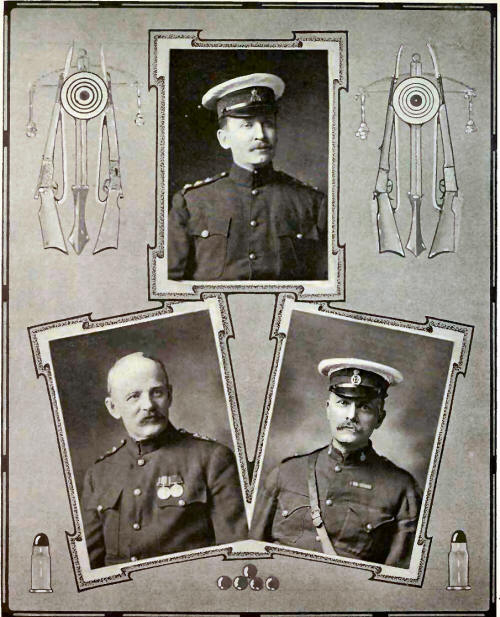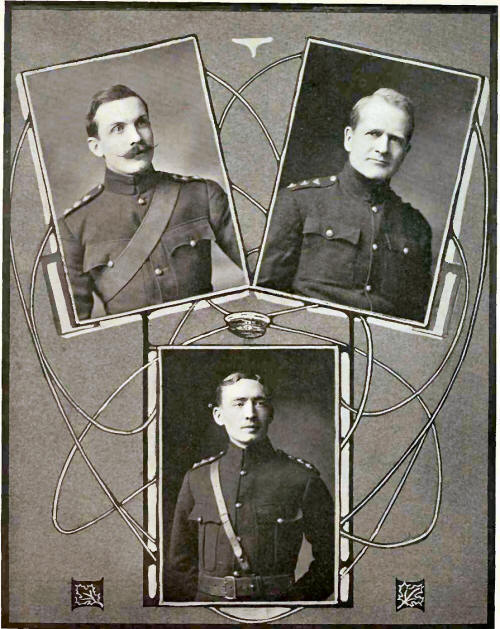|
The Four Thousand
Muskets at the City Hall
THE troubles known to
history as the Mackenzie Rebellion are really divisible into two
distinct periods. First, the rebellion itself before it became an
international affair; and secondly, the Mar of Filibusters that began
with the burning of the Caroline on December 29th, 1897. 'The success or
failure of Mackenzie's attempt to overthrow the government of Sir
Francis Head did not depend on any preponderance of loyalty or
disaffection, but on something very material and confined in a very
small space—namely on the four thousand stand of arms lying in their
unbroken packages at the City Hall in Toronto. Let us see why.
Of all the governors who by the blunder of a statesman (or the mistake
of a messenger) 1 have vexed Britain’s over-seas dominions, Sir Francis
Bond Head was by the quality and exercise of his undoubted talents the
best fitted to lose a British Colony.
While exasperating the Reformers to the verge of rebellion, he was
scarcely less irritating to the upholders of the Family Compact, who
found him resentful of their advice and determined to pull the roof down
over his own and their heads. The reform agitation had up till August
15th, 1837, been a spirited, but not overtly unlawful propaganda by
public meetings and white-hot publications. About this date some fifty
Orangemen with clubs adjourned one of Mackenzie’s meetings. The answer
to this line of argument took the form of an escort of one hundred
horsemen, who accompanied the agitator to his Vaugh&n meeting.
The project launched by Mackenzie in July for uniting, organizing and
registering the Reformers of Upper Canada as a political union,’ began
as he foresaw to take a military direction. The various branches or
societies, which he had instituted, began to take an unwonted interest
in rifle matches and turkey shoots and to collect pike-heads, doubtless
for their symbolic value.
These matters were duly reported to Sir Francis Head, who secure in his
sense of popularity, not only refused to take any precautions to meet an
outbreak, but in spite of the most alarming information sent every
regular soldier out of the province to help against Papineau in Quebec.
The garrison having disappeared, the insurgents had two chances to get
the four thousand muskets upon whose possession depended the fate of an
appeal to arms. Mackenzie, while disclaiming

Capt. W. B. Hamilton, Commanding A
Company, Capt. W. H. Taylor, Commanding B Company Capt W. G. Fowler,
Commanding C Company.
a military capacity
knew the general scarcity of tire arms,3 and proceeded in his
characteristic way to improve his first chance of getting that
superiority of fire which determines battles. His plan was “that we
should instantly send for Dutcher’s foundry-men and Armstrong’s
axe-makers, all of whom could have been depended on, and with them go
promptly to the Government House, seize Sir Francis, carry him to the
City Hall, a fortress in itself, seize the arms and ammunition there and
the artillery, etc., in the old garrison; rouse our innumerable friends
in town and country, proclaim a provisional government,” etc., etc.
Viewing the matter in the light of what actually did happen, one is
struck by the entire feasibility of the plan and by the utter imbecility
displayed by Mackenzie in his method of execution. For instead of going
himself with a few tried friends, and collecting Dutcher’s and
Armstrong’s men, he propounded his manoeuvre to a meeting of fourteen or
fifteen of the most fluent and sub-heroic orators in his party; with the
result that they talked it out until it joined the innumerable list of
great deeds that might have been done.
Inevitably some one told Sir Francis Head and consistently with his
character he would neither do anything himself, nor permit anyone else
to do anything for the defence of his person, capital or province.
About this time there was in Toronto a certain veteran soldier of 1812,
Col. Fitzgibbon, who was making an unqualified nuisance of himself to
the powers-that-be. He made repeated alarmist representations to Head
and his Council of an impending rebellion and was loftily snubbed by the
Governor, the Judges and the Attorney-General. Indeed the only man of
official standing in Toronto that gave heed to his utterances appears to
have been Hon. Win. Allan, whom we have mentioned in his militia
capacity in previous chapters. Despite his chilling lack of
encouragement, Fitzgibbon got up a list of one hundred and twenty-six
men (out of the twelve thousand inhabitants of the city) upon whose
loyalty lie could depend. Taking this list to Sir Francis he informed
him that with or without his permission he intended to keep these men on
duty so that on the ringing of the college bell they should assemble at
the City Hall. When the matter was presented to him in this manner Sir
Francis gave a grumbling assent. As a matter of history this little
contingent was all that stood between Head and the successful issue of
Mackenzie’s second plan for the capture of the four thousand muskets.
This plan was one of those intricate combinations which can only succeed
in the entire absence of any military precaution or capacity on the part
of those who are to be overthrown. Mackenzie schemed to concentrate his
followers from Dan to Beersheba at a point in York County, and march
thence upon the city before the Government, could collect its friends.
The date fixed a as Thursday, 7th December, 1837, and Montgomery’s
Tavern on Yonge Street was the rendezvous.
Two unforeseen circumstances broke lip the combination. The first was
that Dr. Rolph, a brilliant orator and bad conspirator, got alarmed at
the state of unrest in Toronto, and thinking the plan had been
discovered changed the date to the 4th December. This had the result
that only a portion of the would-be-rebels got notice in time to join
Mackenzie. The others either went out later with Dr. Duncombe in the
west, and being practically unarmed, dispersed without battle; or
hastening to the scene of trouble and hearing of the fiasco at
Montgomery’s Tavern became forthwith Her Majesty’s most loyal militia.
The other circumstance was that the irrepressible Fitzgibbon despite the
most explicit order of Sir Francis Head posted a forbidden and unthanked
picket on Yonge Street.
On Monday, the 4th December, 1837, the Rebellion actually broke out and
on Tuesday night the rebels, having been amused for several hours by
flags of truce, moved down Yonge Street to take the city. Their advance
guard struck the picket commanded bjp Sheriff 1\ Ik Jarvis. The picket
fired and ran in. The rebels also ran,—some eight hundred of them,- and
retired to Montgomery’s Tavern. To put it mildly the city was alarmed;
even Sir Francis Head dressed himself and added to the confusion at the
City Hall by issuing absurd orders. The arrival of Allan McNab from
Hamilton with sixty men of Gore saved the situation by distracting the
attention of Sir Francis from the confusion he was maintaining. The
subsequent events—the. advance of the now numerous volunteers with,
their muskets and cannon against the rebels of whom but two hundred had
fire arms; the foregone conclusion at Montgomery’s Tavern,—these are now
ancient history.
Now where among all this confusion was the militia of whom as we have
seen there were among the notables of the province such numerous
colonels, lieutenant-colonels, majors and captains (not to mention one
lieutenant). It seems, indeed, that these great men were not without the
spirits of soldiers even if the bodies were invisible. For an
eye-witness of the scene at the Market Place in Toronto on the morning
of the 5th December, after the college bell had rung during the night,
writes:—"I found a large number of persons serving out arms to others as
fast as they possibly could. Among others, we saw the
Lieutenant-Governor in his every-day suit with one double barrelled gun
in his hand, another leaning against his breast and a brace of pistols
in his leathern belt. Also Chief Justice Robinson, Judges Macaulay,
Jones and McLean, the Attorney-General and Solicitor-General with their
muskets, cartridges, boxes and bayonets, all standing in ranks as
private soldiers under the command of Col. Fitzgibbon.”
A spirited description of the militia man of 1837 is to be found in
Lindsay’s “Life of Mackenzie”:
“The militia who went to the succor of the Government was not generally
a more warlike body of men than the insurgents under Fount.6 These were
drawn from the same class—the agriculturists- and were similarly armed
and equipped A description of a parly as given to me by an eye-witness-
who came down from the North, would answer, with a very slight
variation, for the militia of any other part of the province. A number
of persons collected at Bradford, on the Monday or Tuesday, not
one-third of whom had arms of any kind; and many of those who were armed
had nothing better than pitchforks, rusty swords, dilapidated guns, and
newly manufactured pikes, with an occasional bayonet on the end of a
pole. These persons, without the least authority of law, set about a
disarming process; depriving every one who refused to join them, or whom
they chose to suspect of disloyalty, of his arms. Powder was taken from
stores, wherever found, without the least ceremony, and without payment.
On Thursday, a final march from Bradford for Toronto was commenced; the
number of men being nearly five hundred, including one hundred and fifty
Indians, with painted faces and savage looks. At Holland Landing some,
pikes, which probably belonged to Lount, were secured. In their
triumphant march, these grotesque-looking militiamen made a prisoner of
every man who did not give such an account of himself as they deemed
satisfactory. Each prisoner, as he was taken, was tied to a rope; and
when Toronto was reached a string of fifty prisoners all fastened
together were marched in. Tearing an ambush, these recruits did not
venture to march through the Oak Ridges in the night; and a smoke being
seen led to the conclusion that Toronto was in flames. McLeod’s tavern,
beyond the Ridges, was taken possession of, as well as several other
houses in the vicinity. In a neighbouring store, all kinds of provisions
and clothing that could be obtained were unceremoniously seized. At the
tavern there was a regular scramble for food; and cake-baking and
bacon-frying were going on upon a wholesale scale. Next morning, several
v ho had no arms, and others who were frightened, returned to their
homes. Each man wore a pink ribbon on his arm to distinguish him from
the rebels. Many joined from compulsion; and a larger number, including
some who had been at Montgomery's, suddenly turned loyalists when they
found the fortunes of the insurrection had become desperate. When they
marched into Toronto, they were about as motley a collection as it would
be possible to conceive.
“Such was the Canadian militia in 1837, at a time when Sir Francis Bond
Head had sent all the regular troops out of the province.’’

Capt. B. H. Brown, Commanding F Company, Capt. A. T. Hunter,
Commanding G Company, Capt. S. E. Curran, Commanding H Company |
